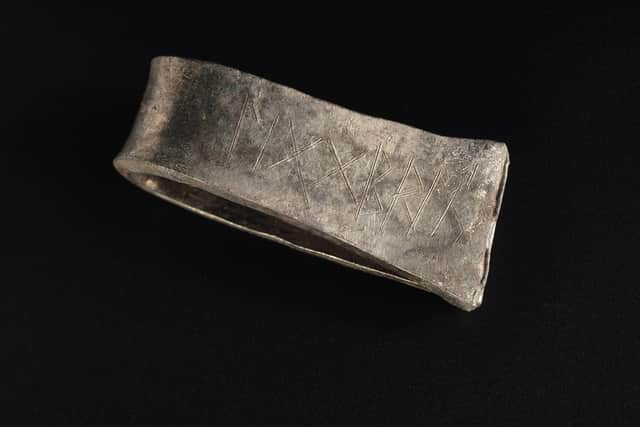Did the Vikings even exist? New research unravels stereotypes of the Scandinavian invaders in Scotland
The image of the violent Viking raiding invader is perhaps one of history’s most enduring – and lucrative – images.
But as research builds to suggest new arrivals from Scandinavia never shared a single identity and adopted and shared culture, styles and ideas, a leading authority on the age in Scotland is testing the theory if Vikings ever existed at all.
Advertisement
Hide AdAdvertisement
Hide AdDr Adrián Maldonado, from National Museums Scotland, will share his thinking at the Edinburgh Fringe Festival’s Cabaret of Dangerous Ideas, hosted by comedian Susan Morrison. The show follows years of research into the Viking age in Scotland, including the Galloway Hoard of treasures buried in the ninth century, which contains some serious clues to the cross cultural melting pot – and fast-changing identities – of the time.


Dr Maldonado said: “The people who are studying the Vikings can see how mixed up, hybrid and kind of novel and creative it all is. It is not just people coming form Norway and Denmark and replacing everyone who they come across. It is a lot more interesting, it is messy and it is complicated – but it is fascinating.”
He said some scholars had dropped the capital V for Viking to “take some of the power” out of the word, with the term itself being occupational and a reference to seafarers and seaborne pirates and its common use emerging only in the 19th century.
Dr Maldonado said: “In Britain and Ireland, they use Hiberno-Norse or Anglo-Scandinavian and in the west of Scotland, in the isles, in Strathclyde, you get the whole new thing called the Gall-Goídil, which is the stranger Gaels or the foreigner Gaels, that comes from the sources in the 9th century in Ireland.
"That is a real term they are using in Ireland because there is a new kind of people who are bilingual. They are speaking Norse and Gaelic and it sounds like they are dressing in a way that it neither from Norway or from Ireland and dressing in new ways, speaking in new ways and doing things in a different way. We call them Vikings, but at the time they were called something else because it was new and it was a bit of both – it was foreigners and Gaels mixed together.”
Dr Maldonado said the 20th-century growth and popularity of Viking archaeology, when research brought the period out of “fairytales and sagas”, had given way to a greater nuance surrounding the period.
He said: “Now, people who are studying Vikings are the ones doing all the hyphenation, the ones telling us to spell Vikings with a lower case ‘v’ and that it is not Scandinavian, it is Anglo-Scandinavian. It is the very people who are doing this Viking stuff who are telling us ‘actually we need to be more careful with this’.”
Dr Maldonado’s book Crucible of Nations: Scotland from the Viking age to Medieval kingdom, emerged out of the museum’s link with The Glenmorangie Company Research Project, and has refreshed the understanding of star objects in the Viking age collection.
Advertisement
Hide AdAdvertisement
Hide AdHe said: "The more I looked, the more I found they were a mix of things, They have plenty of Viking swords in the collection for instance, but when you start to write about them you have to hyphenate everything again and these Viking swords are copies of Frankish swords, they are swords being used in France and Germany at the time by the most powerful kings and emperors under Charlemagne.”
Meanwhile, the ringed pin used to fasten a cloak – the “calling card” of the Vikings – turned out to be an Irish object.
Dr Maldonado said: “Vikings start taking a shine to it and they start mass producing it until it becomes this whole Viking thing, but originally it is an Irish dress fastener.
“The pin is telling us that they are changing their dress. It might be that they are taking this item of clothing.”
He said the “killer evidence” of changing identities was the Galloway Hoard, which was buried in Kirkcudbrightshire around the ninth century and discovered by a metal detectorist in 2014.
Described as a Viking hoard for many years, ongoing analysis has confirmed Anglo Saxon brooches among the treasures as well as Scandinavian-style chopped armbands, which bore hallmarks of the English-speaking Kingdom of Northumbria that controlled Galloway at the time. One of the pieces of armband was inscribed with Ecgbeorht – of Egbert – a very common name in Northumbria at the time. It was written in Anglo-Saxon runes.
Dr Maldonado said: "In this case it looks very much like someone who is an English speaker, or a group of people who are speaking English and have English brooches, are the ones signing and burying the hoard and that can mean anything.
“It is not just that Vikings are coming here and adapting to ways of living here. People here are also taking on these new ideas and they are plugging into that economy. Before long, they are building ships that start to look like theirs, they are starting to dress like them and maybe they are becoming bilingual and fully Norse speakers.
Advertisement
Hide AdAdvertisement
Hide Ad"It is possible that everyone is changing at this time. It is just a bunch of new ideas smashing together and creating something new and it involves everyone.
“It involves Picts, it involves Anglo Saxons and it involves Irish people and so basically the people and the things that we call Viking are something new altogether – and we might not even need Scandinavians to be part of it.”
Dr Adrián Maldonado will appear at the Cabaret of Dangerous Ideas at the Studio, New Town Theatre, Freemasons Hall, 96 George Street, on August 26 at 11.55am.
Comments
Want to join the conversation? Please or to comment on this article.